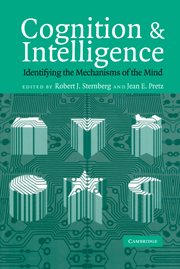Book contents
- Frontmatter
- Contents
- Preface
- 1 Information Processing and Intelligence: Where We Are and Where We Are Going
- 2 Mental Chronometry and the Unification of Differential Psychology
- 3 Reductionism versus Charting: Ways of Examining the Role of Lower-Order Cognitive Processes in Intelligence
- 4 Basic Information Processing and the Psychophysiology of Intelligence
- 5 The Neural Bases of Intelligence: A Perspective Based on Functional Neuroimaging
- 6 The Role of Working Memory in Higher-Level Cognition: Domain-Specific versus Domain-General Perspectives
- 7 Higher-Order Cognition and Intelligence
- 8 Ability Determinants of Individual Differences in Skilled Performance
- 9 Complex Problem Solving and Intelligence: Empirical Relation and Causal Direction
- 10 Intelligence as Smart Heuristics
- 11 The Role of Transferable Knowledge in Intelligence
- 12 Reasoning Abilities
- 13 Measuring Human Intelligence with Artificial Intelligence: Adaptive Item Generation
- 14 Marrying Intelligence and Cognition: A Developmental View
- 15 From Description to Explanation in Cognitive Aging
- 16 Unifying the Field: Cognition and Intelligence
- Author Index
- Subject Index
- References
16 - Unifying the Field: Cognition and Intelligence
Published online by Cambridge University Press: 23 November 2009
- Frontmatter
- Contents
- Preface
- 1 Information Processing and Intelligence: Where We Are and Where We Are Going
- 2 Mental Chronometry and the Unification of Differential Psychology
- 3 Reductionism versus Charting: Ways of Examining the Role of Lower-Order Cognitive Processes in Intelligence
- 4 Basic Information Processing and the Psychophysiology of Intelligence
- 5 The Neural Bases of Intelligence: A Perspective Based on Functional Neuroimaging
- 6 The Role of Working Memory in Higher-Level Cognition: Domain-Specific versus Domain-General Perspectives
- 7 Higher-Order Cognition and Intelligence
- 8 Ability Determinants of Individual Differences in Skilled Performance
- 9 Complex Problem Solving and Intelligence: Empirical Relation and Causal Direction
- 10 Intelligence as Smart Heuristics
- 11 The Role of Transferable Knowledge in Intelligence
- 12 Reasoning Abilities
- 13 Measuring Human Intelligence with Artificial Intelligence: Adaptive Item Generation
- 14 Marrying Intelligence and Cognition: A Developmental View
- 15 From Description to Explanation in Cognitive Aging
- 16 Unifying the Field: Cognition and Intelligence
- Author Index
- Subject Index
- References
Summary
In 1957, Lee Cronbach called on psychologists to integrate research on cognition and intelligence, and this volume has been dedicated to presenting a progress report of the work in this field. This final chapter will summarize and synthesize the work reported in this volume, and will conclude with an evaluation of our status with respect to Cronbach's call and suggestions for future work in the field.
Research on cognition and intelligence can be characterized as either bottom-up or top-down. Bottom-up approaches focus on identifying the basic information processes, usually measured by elementary cognitive tasks, that underlie individual differences in traditional psychometric tests of cognitive ability. In contrast, top-down approaches study the relationship of intelligence to complex cognitive tasks such as complex problem solving, decision making, and transfer. Each approach brings with it theoretical and methodological strengths and weaknesses, research questions it can and cannot answer. In some ways, these two distinct approaches complement each other, but it is also true that the differences in the research programs' methodologies and assumptions often make it difficult to compare results and synthesize an understanding of the role of cognition in intelligence.
The future of research on cognition and intelligence depends on the willingness of researchers to agree on a set of ground rules and to stretch their comfort zones in terms of their research methods and assumptions.
- Type
- Chapter
- Information
- Cognition and IntelligenceIdentifying the Mechanisms of the Mind, pp. 306 - 318Publisher: Cambridge University PressPrint publication year: 2004
References
- 1
- Cited by



